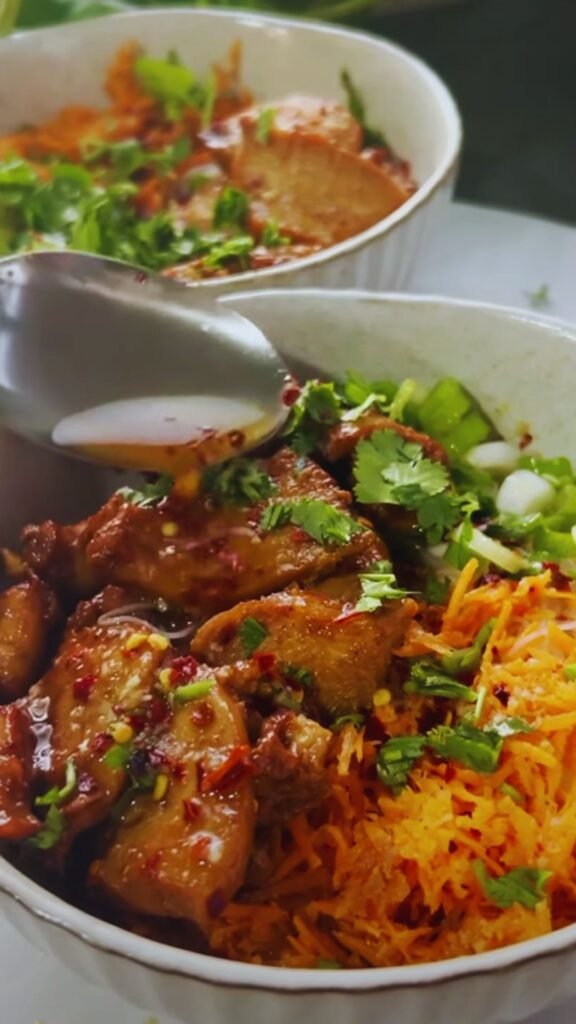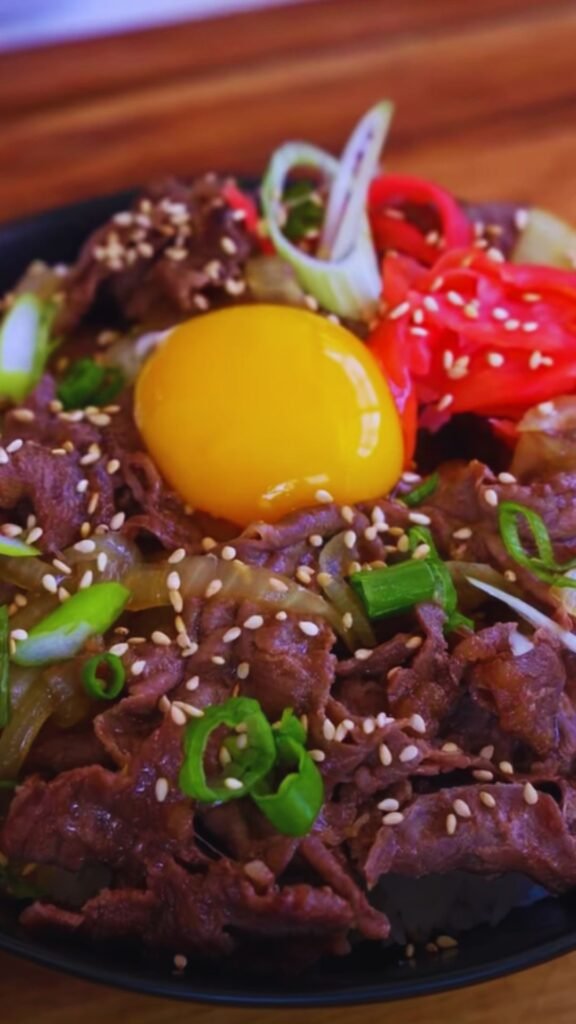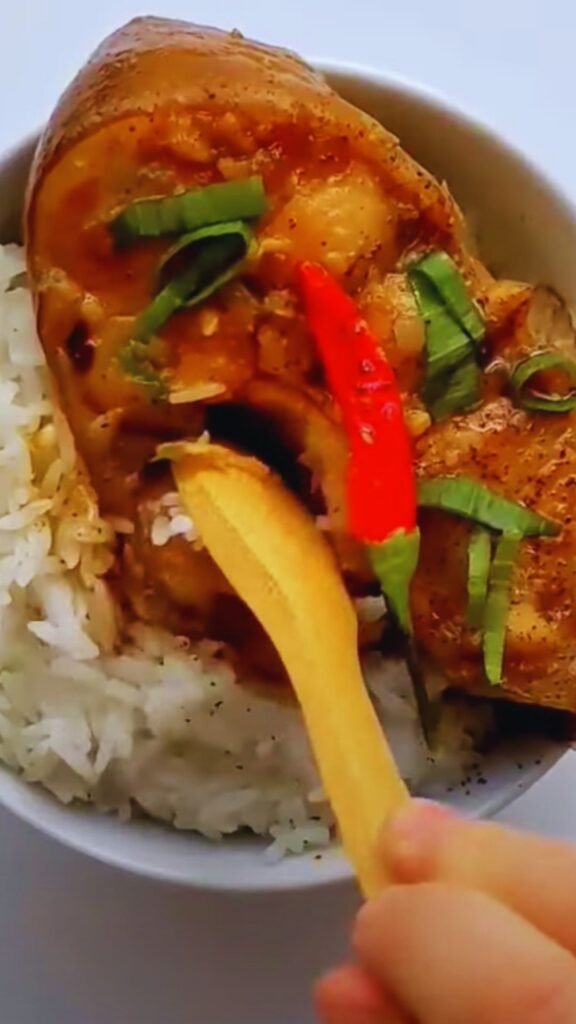There’s something magical about the combination of sweet, savory, and spicy flavors that makes Vietnamese cuisine so irresistible. One of my absolute favorite dishes to make at home is Vietnamese Caramel Beef Bowls – a delightful combination of tender beef coated in a sticky, complex caramel sauce served over fluffy rice with fresh herbs and vegetables. This dish captures the essence of Vietnamese cooking: bold flavors, contrasting textures, and a beautiful balance that keeps you coming back for more.
I’ve been perfecting this recipe for years, tweaking the ingredients and methods until I found the perfect balance. What makes this dish special is the caramelization process – it might sound intimidating, but I’ll walk you through it step by step, and I promise the results are worth it. The dark, glossy caramel sauce gives the beef an incredible depth of flavor that you simply can’t achieve any other way.
Whether you’re looking to expand your weeknight dinner repertoire or impress guests with something different, these Vietnamese Caramel Beef Bowls will definitely hit the spot. Let’s dive into this flavor-packed dish that brings a taste of Vietnam right to your kitchen!
The History Behind Caramel Beef
Before we get to cooking, I want to share a bit about this dish’s origins. In Vietnamese cuisine, this style of cooking is called “thịt kho” (pronounced “teet kaw”), which translates to “meat braised in caramel sauce.” The technique of cooking with caramel is deeply embedded in Vietnamese culinary tradition and dates back centuries.
Traditionally, this cooking method was developed as a preservation technique in a hot climate without refrigeration. The caramelization process, combined with fish sauce and aromatics, creates an environment that slows spoilage while infusing the meat with incredible flavor. In Vietnam, this technique is commonly used with pork, fish, chicken, and beef.
What I find fascinating is how the dish balances the five fundamental flavors in Vietnamese cooking:
- Sweet: from the caramelized sugar
- Salty: from the fish sauce
- Sour: from lime juice
- Spicy: from chili peppers
- Umami: from the braised meat and fish sauce
This thoughtful balance is what makes Vietnamese cuisine so distinctive and delicious. Now, let’s get to the recipe!
Ingredients You’ll Need
For the Caramel Beef
- 1½ pounds beef chuck or sirloin, thinly sliced against the grain
- ⅓ cup granulated sugar
- 3 tablespoons fish sauce
- 2 tablespoons soy sauce
- 1 tablespoon dark soy sauce (for color)
- 2 tablespoons fresh lime juice
- 2 tablespoons vegetable oil
- 1 medium onion, thinly sliced
- 4 cloves garlic, minced
- 2 tablespoons ginger, finely grated
- 1-2 red chili peppers, thinly sliced (adjust to your heat preference)
- 1 cup beef broth or water
- 1 tablespoon cornstarch mixed with 2 tablespoons water (slurry)
- 2 green onions, sliced for garnish
For the Bowls
- 3 cups cooked jasmine rice
- 2 cups mixed fresh herbs (cilantro, Thai basil, mint)
- 1 cucumber, thinly sliced
- 2 carrots, julienned or shredded
- 1 cup bean sprouts
- ¼ cup chopped roasted peanuts
- Lime wedges for serving

Kitchen Equipment
Before we start cooking, make sure you have these tools ready:
- Heavy-bottomed saucepan or Dutch oven (crucial for making caramel)
- Sharp knife for slicing beef thinly
- Cutting board
- Mixing bowls
- Wooden spoon or heat-resistant spatula
- Rice cooker or pot for cooking rice
- Measuring cups and spoons
- Small bowl for cornstarch slurry
The Art of Making Caramel
The caramel is the heart and soul of this dish, so let’s talk about how to make it perfectly. This isn’t the sweet caramel you’d drizzle over ice cream – Vietnamese cooking caramel (or “nước màu” – pronounced “nook mao”) is darker and less sweet, with complex bitter notes that balance the dish.
Here’s my foolproof method:
- Add ⅓ cup sugar to a heavy-bottomed saucepan over medium heat.
- Let the sugar melt without stirring – just swirl the pan occasionally.
- As it melts, the sugar will begin to change color – first clear, then golden, amber, and finally a deep reddish-brown.
- Once it reaches a deep amber color (about 5-7 minutes), remove from heat immediately.
- Very carefully add ¼ cup warm water (it will bubble vigorously – stand back!).
- Return to low heat and stir until the caramel is fully dissolved.
The goal is to take the caramel almost to the edge of burning but not beyond. This gives you that characteristic bitter-sweet flavor that makes Vietnamese caramel dishes so distinctive.
Pro tip: If you’re nervous about making caramel from scratch, you can substitute 3 tablespoons of brown sugar with a splash of water. The flavor won’t be quite as complex, but it’s a good shortcut for beginners.
Step-by-Step Cooking Instructions
Preparing the Beef
- Slice your beef as thinly as possible against the grain. This is easier if the beef is partially frozen.
- Place the beef slices in a bowl and set aside while you prepare the sauce.
Making the Sauce
- Prepare the caramel as described above.
- Once the caramel is dissolved in water, add fish sauce, soy sauce, dark soy sauce, and lime juice to the caramel. Stir to combine.
- Pour about half of this mixture over the sliced beef, toss to coat, and let marinate for at least 30 minutes (longer is better – even overnight in the refrigerator).
Cooking the Dish
- Heat 2 tablespoons of vegetable oil in a large wok or heavy-bottomed pan over high heat.
- Add the sliced onions and stir-fry for 1-2 minutes until they begin to soften.
- Add the minced garlic, grated ginger, and sliced chilies. Stir-fry for 30 seconds until fragrant.
- Add the marinated beef (reserving any excess marinade) in small batches, being careful not to overcrowd the pan. Sear quickly on high heat, about 1-2 minutes per batch.
- Return all beef to the pan, add the reserved marinade and the remaining caramel sauce mixture.
- Pour in the beef broth or water, bring to a simmer, then reduce heat to medium-low.
- Cover and simmer for about 20-30 minutes for tender beef (chuck will need closer to 30 minutes, while sirloin will cook faster).
- Once the beef is tender, stir in the cornstarch slurry and simmer for another 2-3 minutes until the sauce thickens to a glossy consistency that coats the beef.
- Taste and adjust seasoning if needed.

Assembling the Bowls
- Place a generous portion of jasmine rice in each bowl.
- Top with the caramel beef and some of its sauce.
- Arrange fresh herbs, cucumber slices, carrots, and bean sprouts on one side.
- Sprinkle with chopped peanuts and sliced green onions.
- Serve with lime wedges on the side.
Nutritional Information
Here’s a detailed breakdown of the nutritional content per serving (assuming 4 servings from this recipe):
| Nutrient | Amount | % Daily Value* |
|---|---|---|
| Calories | 620 | – |
| Total Fat | 24g | 31% |
| Saturated Fat | 7g | 35% |
| Cholesterol | 85mg | 28% |
| Sodium | 1120mg | 49% |
| Total Carbohydrates | 62g | 23% |
| Dietary Fiber | 4g | 14% |
| Sugars | 14g | – |
| Protein | 38g | 76% |
| Vitamin A | 6050IU | 121% |
| Vitamin C | 18mg | 20% |
| Calcium | 80mg | 8% |
| Iron | 5mg | 28% |
*Percent Daily Values are based on a 2,000 calorie diet.
Tips for Perfect Vietnamese Caramel Beef
Over the years, I’ve discovered several tricks that take this dish from good to exceptional:
- Freeze the beef partially before slicing: Put the beef in the freezer for about 20-30 minutes before slicing. This firms it up, making it easier to get those paper-thin slices that cook quickly and stay tender.
- Don’t rush the caramel: The caramel is the foundation of the dish’s flavor. Take your time and watch it carefully as it darkens. The perfect color is a deep amber, similar to maple syrup.
- Use room temperature water for the caramel: Adding cold water to hot caramel can cause it to seize up. Room temperature or slightly warm water will help it dissolve smoothly.
- Cook in batches: When searing the beef, don’t overcrowd the pan. Cook in small batches to ensure each piece gets properly browned rather than steamed.
- Balance the fish sauce: Fish sauce is potent! If you’re sensitive to its flavor, start with less and add more to taste. The caramel and lime juice will help balance its intensity.
- Fresh herbs are non-negotiable: The fresh herbs aren’t just a garnish—they’re integral to the dish, providing freshness and aroma that balances the rich beef.

Variations to Try
One thing I love about this dish is how versatile it is. Here are some variations I enjoy:
Lemongrass Caramel Beef
Add 2 stalks of finely minced lemongrass when you add the garlic and ginger. The citrusy, floral notes of lemongrass bring a whole new dimension to the dish.
Coconut Caramel Beef
Replace half of the beef broth with coconut milk for a creamier, slightly sweeter sauce that’s absolutely divine.
Vegetable-Packed Version
For a more nutritious bowl, stir-fry bell peppers, broccoli, and snap peas with the beef. The vegetables soak up the caramel sauce beautifully.
Spicy Caramel Beef
Double the chilies and add a tablespoon of sambal oelek or sriracha for a fiery kick that contrasts wonderfully with the sweet caramel.
Citrus Caramel Beef
Add the zest of one orange along with the lime juice for a bright, citrusy note that complements the rich caramel.
Make-Ahead and Storage Tips
This dish actually improves with time as the flavors meld together, making it perfect for meal prep:
- Make-ahead: You can prepare the caramel beef 1-2 days ahead and refrigerate it. The flavors will intensify, making it even more delicious.
- Storage: Store leftovers in an airtight container in the refrigerator for up to 3 days.
- Freezing: The beef component freezes well for up to 3 months. Thaw overnight in the refrigerator before reheating.
- Reheating: Gently reheat on the stovetop with a splash of water to loosen the sauce. Avoid microwaving if possible as it can make the beef tough.
- Fresh components: Always prepare the rice, herbs, and vegetables fresh when you’re ready to serve, even if you’re using leftover beef.
Serving Suggestions
To create a complete Vietnamese feast, consider serving these caramel beef bowls with:
- Fresh Spring Rolls: Light rice paper rolls filled with shrimp, herbs, and rice vermicelli make a perfect starter.
- Vietnamese Iced Coffee: The sweetness of condensed milk coffee pairs wonderfully with the savory beef.
- Pickled Vegetables: A side of pickled daikon and carrots (đồ chua) adds a tangy crunch that cuts through the richness of the beef.
- Nuoc Cham Dipping Sauce: Offer a small bowl of classic Vietnamese dipping sauce on the side for drizzling over the vegetables.
- Tropical Fruit Platter: End the meal with fresh mango, lychee, or dragon fruit for a light, refreshing dessert.
The Cultural Significance
In Vietnamese culture, caramelized dishes like this hold a special place. They’re often prepared for special occasions and family gatherings, symbolizing the sweet and enduring nature of relationships. The balance of flavors – sweet, salty, sour, spicy, and umami – represents harmony, an important concept in Vietnamese philosophy and cuisine.
When I make this dish at home, I love to share not just the food but also these cultural elements with friends and family. It creates a deeper appreciation for the meal and the thought that went into developing these cooking techniques over generations.
Commonly Asked Questions
Q: Can I use a different cut of beef?
A: Absolutely! While chuck and sirloin are my favorites for this dish, you can also use flank steak, skirt steak, or even tenderloin. Just adjust your cooking time accordingly – tenderloin will need much less time to become tender than chuck.
Q: I don’t have fish sauce. What can I substitute?
A: Fish sauce provides a distinctive umami flavor that’s hard to replicate. In a pinch, you can use additional soy sauce with a dash of Worcestershire sauce, but I highly recommend getting a bottle of fish sauce – it’s a staple in Southeast Asian cooking and will last a long time in your refrigerator.
Q: How spicy is this dish?
A: The spice level is completely adjustable! For a mild version, remove the seeds from the chilies or omit them entirely. For a spicier version, keep the seeds and even add some chili flakes or sambal oelek.
Q: Can I make this in a slow cooker?
A: Yes! Make the caramel sauce as directed, then combine all ingredients (except the cornstarch slurry, herbs, and vegetables) in a slow cooker. Cook on low for 6-7 hours or high for 3-4 hours. Add the cornstarch slurry during the last 30 minutes of cooking.
Q: Is this dish gluten-free?
A: Not as written, due to the soy sauce. However, you can easily make it gluten-free by substituting tamari for the soy sauces and checking that your fish sauce is gluten-free (most are).
Q: Can I use pre-made caramel sauce?
A: I wouldn’t recommend using dessert caramel sauce. The Vietnamese caramel used in cooking (nước màu) has a distinct bitter-sweet profile that’s essential to the dish. If you don’t want to make it from scratch, look for Vietnamese caramel sauce in Asian markets, or use the brown sugar alternative I mentioned.
Q: What if my caramel burns?
A: If your caramel smells acrid or turns black, it’s best to start over. A properly made caramel should have a pleasant bitter note but shouldn’t taste burnt.
Q: Can I make this vegetarian?
A: Yes! You can substitute firm tofu or seitan for the beef. Press the tofu well before using, and reduce the simmering time significantly as these proteins don’t need to tenderize like beef does.
Final Thoughts
Vietnamese Caramel Beef Bowls represent everything I love about cooking – transforming simple ingredients into something extraordinary through technique and tradition. The process of slowly caramelizing sugar and then using it to create a complex, savory-sweet sauce is almost magical, and the result is a dish that balances flavors and textures in perfect harmony.
What I find most rewarding about this recipe is how it connects us to Vietnamese culinary traditions while being accessible enough to make in any home kitchen. Each time I prepare it, I’m reminded of the ingenuity of Vietnamese cooks who developed these techniques centuries ago.
I hope you enjoy making and eating these caramel beef bowls as much as I do. Don’t be intimidated by the caramel-making process – with a little practice, it becomes second nature, and the rich, complex flavor it brings to the dish is absolutely worth the effort. Invite some friends over, set out all the fresh components for everyone to assemble their own bowls, and share in the joy of this delicious Vietnamese classic!


